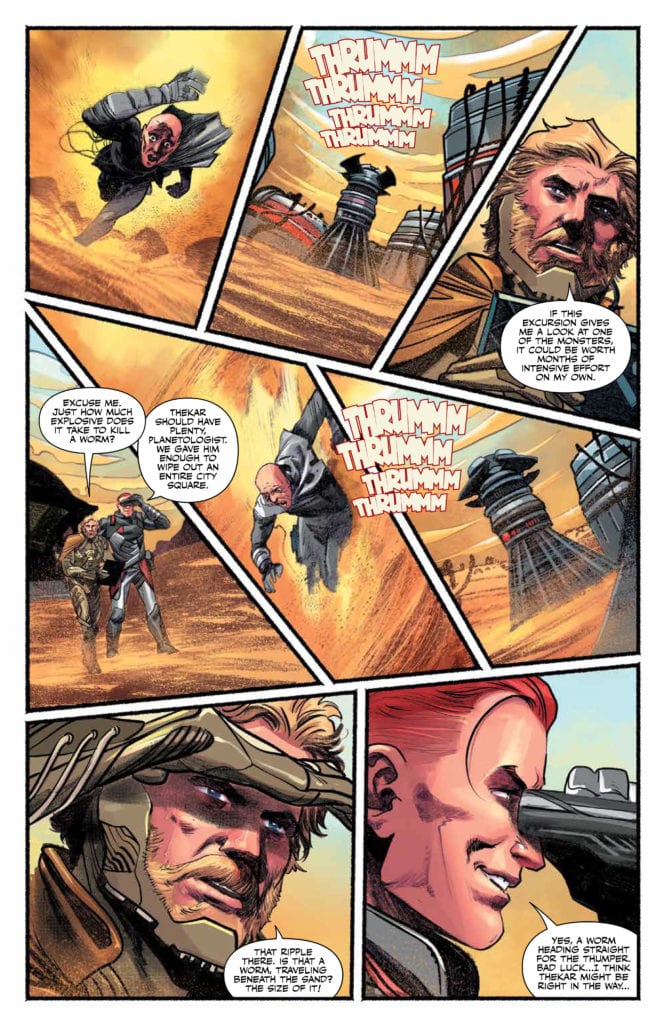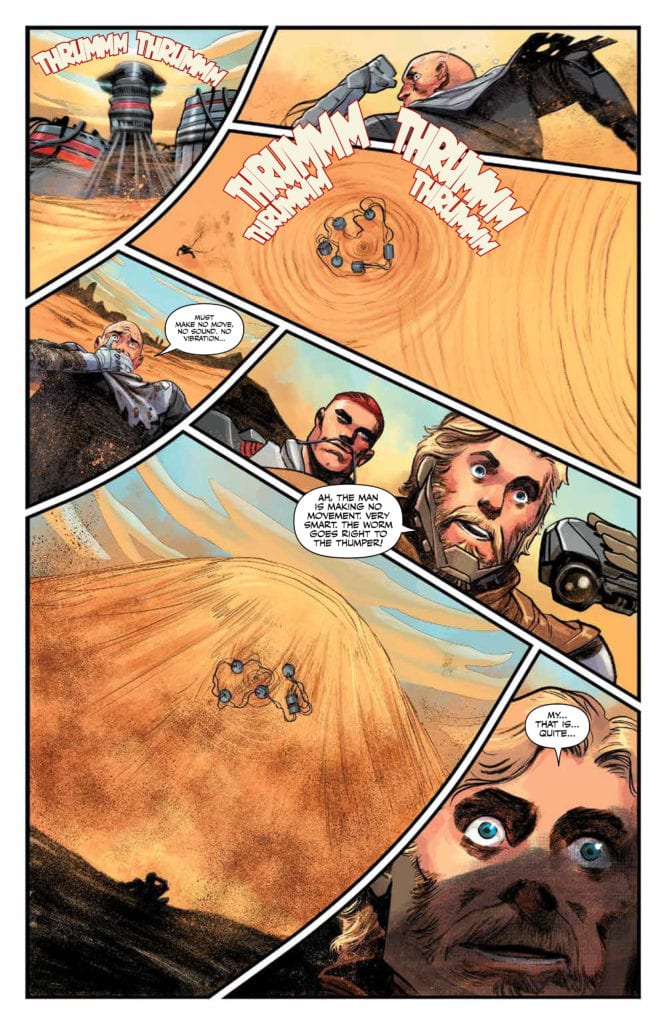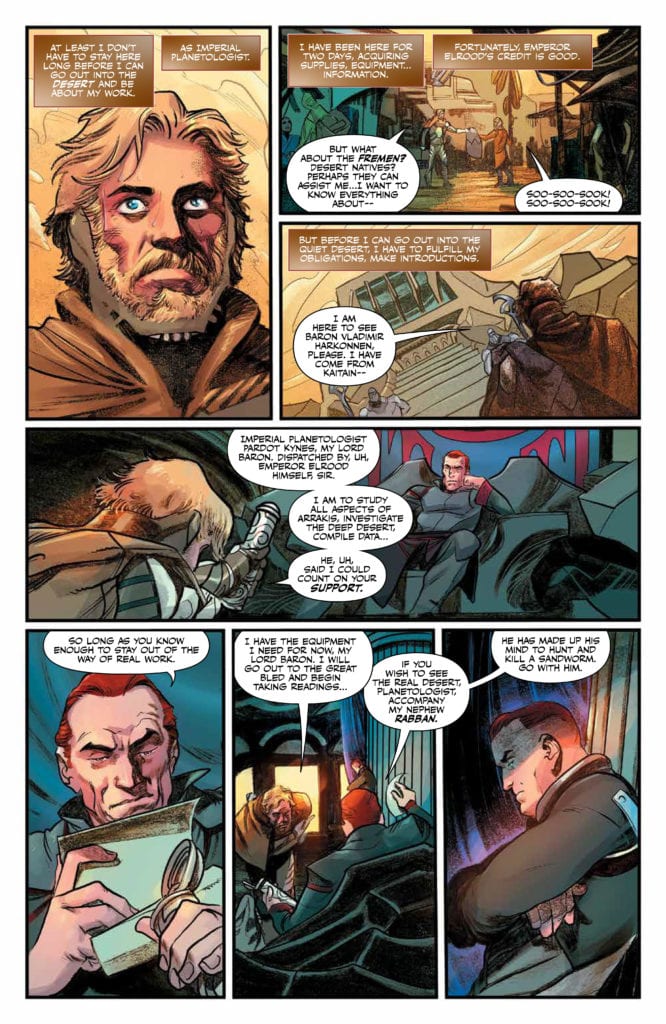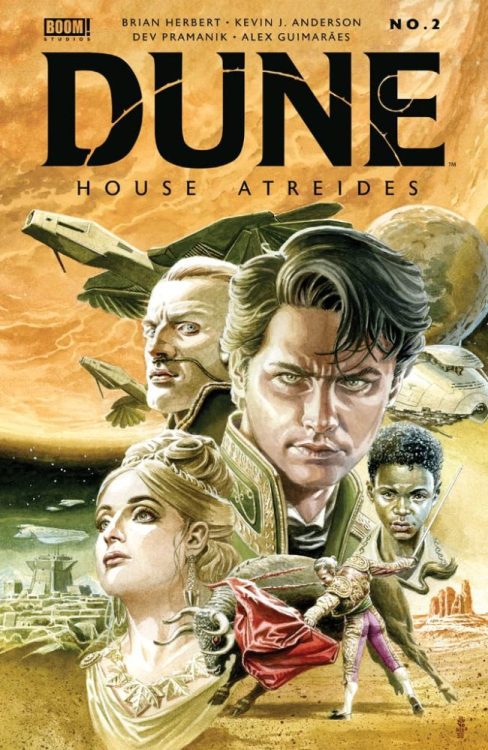There is a new Dune Graphic Novel coming out from Abrams just in time for Christmas, and the movie trailer is still doing the rounds wherever people can get to a cinema. Therefore BOOM! Studios and Dune House Atreides #2 are in a good position to benefit from all the excitement currently being generated for the franchise.
After a scene setting first issue, the prequel adaptation continues to expand the Dune universe by introducing new characters and expanding on the histories of the famous Houses. The titular planet is just a central hub around which a universe of action is beginning to unfold. With such a strong fan base, and numerous visions of the franchise starting to appear, is BOOM!’s version setting the standard for others to follow?

Into the Desert
Setting out from the brutalist city of Carthag, Imperial Planetologist Pardot Kynes is led into a sandy landscape to discover first hand some of the secrets of Dune. The Bene Gesserit outline their extensive breeding program, Duncan Idaho learns of Harkonnen cruelty, and Leto Atreides is abandoned on Ix.
The second issue of this adaptation is split into mini chapters, reading like the original novel by Brian Herbert and Kevin J Anderson. Each section contains an element of discovery, a thematic thread running through the comic. With each discovery a little more can be understood of this vast universe created by Frank Herbert. Characters, families, and religious organisations are being slowly fleshed out for the reader through multiple stories that, as yet, are unconnected.
Herbert and Anderson have adopted their story well from the novel to the comic. However, any newbies to the franchise may find the narrative disconcerting as it leaps from one character to another, like a series of unrelated chapters unfolding on the page. This style of storytelling works better in a longer format, and will enhance the reading experience when this is inevitably collected. However, each bite sized narrative at least contains a satisfying chunk of plot that relates thematically across the entire issue. By the end the reader comes away with some understanding of the world, if not the direction of the plot.

World Design
After reading the first issue last month, the design and art style has had time to sink in. Dev Pramanik sketches his way through the pages and seems to have found a flow that matches the story. His inking has a diffused appearance, creating a hazy landscape and his characters are emotive if a little difficult to read at times.
The layouts are very rigid with heavy black frames on the panels but the shape of the panels change to express the action within them. The lettering also helps to break-up the stiffness in design by occasionally crossing the frames and entering the gutter, drawing the reader back away from the page to help take in the larger picture. Ed Dukeshire has a lot of script to get onto the page but his economy of word balloons and strategic placement means that the action is never interrupted. The sound effects throughout this issue of Dune have a lightness to them and they blend perfectly with the main artwork.
Pramanik’s line work is definitely enhanced by Alex Guimaraes’ colors which clearly separate the chapters. Each world, and by default each central character, has its own atmosphere produced from the shifting color palettes. From the desolate desert of Arrakis to the cold Harkonnen home-world, Guimaraes creates unique environments for the characters to inhabit. The shift from planet to planet is easier to follow because of the shift in color but it also gives the reader a better understanding of each world.

Conclusion
All of the separate elements of this comic work well. They tell the story and build atmospheres that relate specifically to each section of the narrative in a worthwhile way. Elements that make Dune an interesting reading experience in the Novel format are transposed to the comic successfully, especially the inner monologues that sit on the page, color coded for ease.
The plot itself is fast paced enough for the monthly comic format and you get the impression that something is happening, that it is all going somewhere. Comics like this will always feel harder to engage with if you are not used to the franchise but this second issue does a much better job of making readers feel at home. The first issue was a visual cultural shock but this month everything seems to work together better, or maybe the style choice has had time to sink in over the last month. Either way, Dune House Atreides #2 is a satisfying read and it’s beginning to feel a lot more like Dune.


